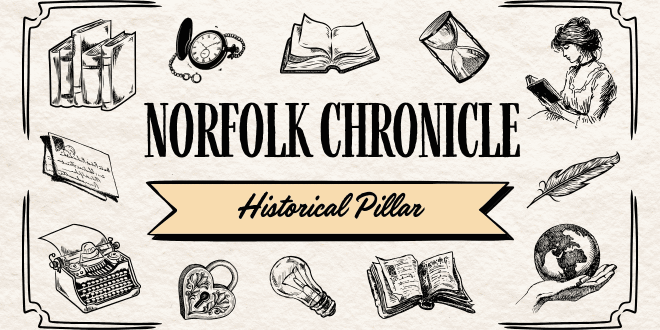The Norfolk Chronicle stands as one of the most significant historical newspapers in the United Kingdom, and particularly in Norfolk. Established in 1761, it has long been a source of local, national, and international news, and its pages reflect the evolving cultural, social, and political landscape of the region. With a rich history spanning over two centuries, the Norfolk Chronicle played a vital role in chronicling the lives, events, and transformations of Norfolk, making it a key player in the development of the area’s journalistic heritage.
In this article, we will delve into the historical significance of the Norfolk Chronicle, its impact on the Norfolk community, its evolution over time, and its continued importance in the age of digital media. We will also explore key milestones in its publication history and why it remains a key archival resource for researchers and local historians alike.
Origins of the Norfolk Chronicle

Early Days: 1761 and the Birth of a Newspaper
The Norfolk Chronicle was founded in 1761 during a period of great change in Britain, both politically and economically. At the time, newspapers were becoming an increasingly important medium for communication, providing the public with access to both local and global news.
Unlike many of its contemporary publications, the Norfolk Chronicle took a distinct approach. Rather than focusing solely on regional affairs, it sought to strike a balance between local, national, and international news, giving Norfolk residents a broad perspective on current events. This approach helped the newspaper build a loyal readership early on, especially among those who wanted to stay informed about both their immediate surroundings and the world at large.
The Founding Vision
The founding editors of the Norfolk Chronicle aimed to create a publication that would serve as a reliable and trusted source of information. Early editions covered a range of topics, including political developments, agricultural updates, trade information, and human interest stories. The editors emphasized accuracy and integrity, building trust among readers who relied on the newspaper as their primary source of news.
The vision behind the Norfolk Chronicle was also to serve as a voice for the region, giving local businesses and politicians a platform to communicate directly with their audience. The newspaper quickly became a staple in Norfolk households, and its growing circulation reflected the demand for quality journalism in the area.
Key Historical Milestones of the Norfolk Chronicle
Covering Major National and Local Events
Throughout its history, the Norfolk Chronicle has been a witness to some of the most critical moments in British history. From the early Industrial Revolution to the Napoleonic Wars and beyond, the newspaper played an essential role in keeping the Norfolk population informed.
The Industrial Revolution
The Industrial Revolution brought rapid changes to British society, and the Norfolk Chronicle was there to document it all. Norfolk, with its agricultural economy, was impacted by industrialization in ways that shaped its future. The newspaper reported on innovations in agriculture, changes in trade and commerce, and the rise of new industries, helping local farmers and business owners navigate these changes.
Articles on new machinery, techniques for increasing crop yields, and the effects of technological advances on local communities were commonly featured. These insights were critical in a time when Norfolk’s economy was undergoing significant transformation.
The Napoleonic Wars
The Norfolk Chronicle provided extensive coverage during the Napoleonic Wars, keeping its readers updated on both the military campaigns abroad and the effects of the war at home. This period was marked by high public interest in political and military affairs, and the newspaper played a pivotal role in shaping public opinion.
Local events related to the war, such as recruitment drives, the return of soldiers, and public ceremonies, were covered in detail. Additionally, the Norfolk Chronicle published letters from soldiers and reports on war casualties, which resonated with readers who had loved ones fighting overseas.
Reporting on Local Norfolk Life
While the Norfolk Chronicle covered major national and international events, its true strength lay in its detailed reporting on local Norfolk life. This focus made the newspaper a trusted voice in the community, as it highlighted the day-to-day affairs of the region.
Agricultural Reports and Rural Life
Norfolk, being predominantly rural, has long had an economy tied to agriculture. The Norfolk Chronicle regularly featured agricultural reports that provided farmers with updates on market prices, crop conditions, and innovations in farming technology. These reports were crucial to the region’s agricultural community, helping them make informed decisions about their livelihoods.
The newspaper also documented local fairs, livestock auctions, and agricultural shows, reflecting the rhythms of rural life. By covering these events, the Norfolk Chronicle played a central role in bringing together the farming community and keeping it informed about the latest developments.
Local Politics and Social Issues
In addition to its agricultural reporting, the Norfolk Chronicle served as a platform for discussing local politics and social issues. It covered elections, town meetings, and public debates, giving readers insight into the workings of local governance. The newspaper also reported on issues such as public health, education, and infrastructure, all of which were important to the development of Norfolk as a region.
The Norfolk Chronicle frequently published letters to the editor, offering a space for readers to express their opinions on local matters. This level of engagement helped foster a sense of community, as it allowed residents to participate in the public discourse and voice their concerns or support for various issues.
The Evolution of the Norfolk Chronicle
Technological Advancements in Printing
Like all newspapers, the Norfolk Chronicle evolved alongside advancements in printing technology. When it was first established, printing presses were labor-intensive, limiting the number of copies that could be produced each day. However, with the introduction of steam-powered presses in the 19th century, the Norfolk Chronicle was able to expand its circulation, reaching more readers than ever before.
As printing technology continued to advance, the newspaper adapted to new methods of production, allowing for faster printing and more detailed coverage. This increased efficiency enabled the Norfolk Chronicle to publish more timely reports, particularly during significant national or local events.
The Shift to Digital Media
With the rise of the internet and digital media, the Norfolk Chronicle—like many traditional print newspapers—faced new challenges. The demand for instant news and the growth of online publications meant that newspapers had to adapt to a digital-first world. In response, the Norfolk Chronicle embraced the digital age, establishing an online presence and making its archives available to a global audience.
Today, the Norfolk Chronicle maintains both print and digital formats, ensuring that its legacy continues in the modern era. The transition to digital media has also allowed the newspaper to reach a broader readership, extending its influence beyond Norfolk.
Read also: Old Norfolk Newspapers: Preserving Norfolk’s Rich History
The Importance of the Norfolk Chronicle in Historical Research
Archiving Norfolk’s Past
The Norfolk Chronicle is one of the most important historical archives available for those studying Norfolk’s past. Its detailed reporting on political, economic, and social events provides historians with invaluable insights into how life in Norfolk has evolved over the centuries. The newspaper’s archives offer researchers an in-depth view of everyday life, major historical events, and the broader societal trends that have shaped the region.
These archives are especially important for genealogists, historians, and researchers who rely on primary sources to trace family histories, study social movements, and understand the local impact of national and international events.
Digital Preservation and Accessibility
In recent years, significant efforts have been made to digitize old issues of the Norfolk Chronicle, making them accessible to a global audience. Digital archives have become a powerful tool for anyone interested in Norfolk’s history, allowing researchers to search through centuries of content with ease.
By preserving the Norfolk Chronicle digitally, future generations will be able to explore Norfolk’s rich history in a way that is both accessible and sustainable. These efforts underscore the importance of ensuring that the stories and voices captured in the Chronicle continue to inform and inspire.
Conclusion
The Norfolk Chronicle stands as more than just a local newspaper—it is a vital record of Norfolk’s history. Since its founding in 1761, it has been a witness to centuries of social, economic, and political changes. From documenting the daily lives of Norfolk residents to providing essential coverage of global events, the Norfolk Chronicle has played an irreplaceable role in the region’s history.
In today’s digital world, the Chronicle continues to evolve, ensuring that the stories of Norfolk’s past remain accessible to all. Its archives are a treasure trove of information, offering unique insights into the lives of those who lived through the region’s most pivotal moments.
As Norfolk Publications continues to share and preserve these historical treasures, the Norfolk Chronicle will remain a pillar of local journalism and a testament to the power of the written word in shaping our understanding of history.
 Norfolk Publications Publications ORG in Norfolk!
Norfolk Publications Publications ORG in Norfolk!

